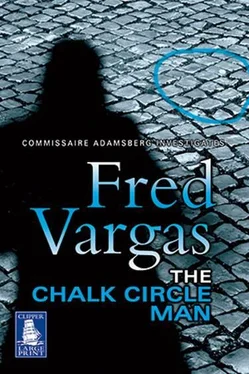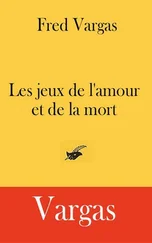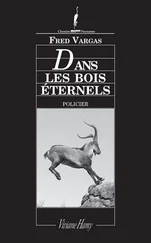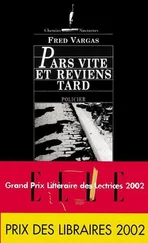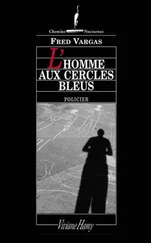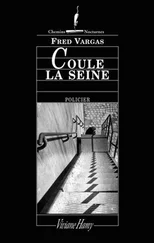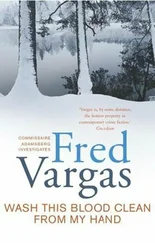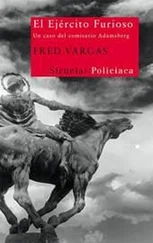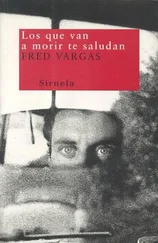‘She’s Clémence Valmont,’ Adamsberg said quietly. ‘Domiciled in Neuilly-sur-Seine. Aged sixty-four. Let me have another drop of cognac, Declerc. It’s not marvellous, you’re right, but it hits the spot.’
‘No!’ said Danglard, more vehemently than they would have expected, though without budging from his tree. ‘No! It can’t be! The doctor’s just told us that this woman’s been dead for months. And Clémence only left the rue des Patriarches in Paris a month ago, alive and well. So how can it be her?’
‘You didn’t listen,’ Adamsberg said. ‘I said Clémence Valmont, domiciled in Neuilly-sur-Seine. Not domiciled in the rue des Patriarches.’
‘So what do you mean?’ asked Castreau. ‘Are there two of them? Two people with the same name? Or twins?’
Adamsberg shook his head, swirling the cognac round the bottom of the cup.
‘There was only ever one,’ he said. ‘Clémence Valmont who lived in Neuilly and who was murdered five or six months ago. That’s her,’ he said, jerking his chin at the grave. ‘And then there was someone else who had been living for two months at Mathilde Forestier’s house in the rue des Patriarches, under the name of Clémence Valmont. Someone who had killed Clémence Valmont.’
‘But who?’ asked Delille.
Adamsberg glanced at Danglard before replying, as if to apologise.
‘A man,’ he said. ‘The chalk circle man.’
They had moved away from the open grave, so as to breathe more freely. Two men took it in turns to do the work. They were now waiting for the technical team to arrive, and the local commissaire from Nevers. Adamsberg had sat down with Castreau beside the van, and Danglard had gone for a walk.
He walked around for half an hour, letting the sun warm his back and restore his lost strength. So the shrew-mouse had been the chalk circle man. The same man who had cut the throats in turn of Clémence Valmont, Madeleine Châtelain, Gérard Pontieux and finally his own wife. Inside his rat-like brain, he had worked out his infernal plan. First of all the circles. Plenty of circles. Everyone thought they were the work of a lunatic. A pathetic maniac who was exploited by a killer. Everything had happened the way he had planned. He had been arrested, and ended up confessing to his mania for doing circles. Just as he had planned. Then he had been released, and everyone had gone chasing after Clémence. The guilty party he had been grooming. Clémence, who had been dead for months, and whom they would have gone on searching for indefinitely, until they had to abandon the case as unsolved. Danglard frowned. Too many things seemed inexplicable.
He rejoined the commissaire who was silently munching some bread with Castreau, both of them seated at the edge of the track. Castreau was trying to attract a hen blackbird with a few breadcrumbs.
‘Why is it,’ Castreau was saying, ‘that the females are always duller-looking than the males? Hen birds are all brown or beige, or some other boring colour. As if they couldn’t care less. But the males are red and green and gold. Why on earth should that be? It looks the wrong way round.’
‘What they say is,’ said Adamsberg, ‘that the males need to make all that fuss to attract a mate. They have to keep on inventing stuff. I don’t know if you’ve noticed that, Castreau. All the time, inventing new stuff. Exhausting.’
The hen blackbird flew off.
‘Well, the female’s got enough to do, inventing eggs and bringing them up, hasn’t she?’ said Delille.
‘Like me,’ said Danglard. ‘I must be a hen blackbird. My eggs give me plenty of headaches, especially the youngest one, who was dumped on me, like a cuckoo in the nest.’
‘Ah, but hold on,’ said Castreau. ‘You don’t wear brown and beige.’
‘Anyway, for God’s sake,’ said Danglard, ‘ornithology is beside the point. You won’t understand people by observing birds. Birds are bloody birds, that’s all there is to it. So why are we talking about them when we’ve got a corpse here and we don’t understand the first thing about what’s going on? At least I don’t. But perhaps you all know everything about everything?’
Danglard was aware that he was going too far, and in other circumstances would have defended a more moderate point of view. But he wasn’t feeling strong enough for that this morning.
‘You’ll have to forgive me for not keeping you filled in on everything,’ Adamsberg said to Danglard. ‘But until this morning I really wasn’t sure of myself. I didn’t want to take you off on a wild-goose chase just because I had a sort of hunch, which you would have torn to pieces by applying reason to it. Your cast-iron reasoning influences me, Danglard, and I didn’t want to take the risk of being influenced until this morning. Or I might have lost the scent.’
‘The scent of rotten apples?’
‘Well, in particular the scent of the circles. Those circles that I really hated. I hated them even more when Vercors-Laury confirmed that we weren’t dealing with some authentic compulsion. Worse, there was no sign of obsession at all. Nothing about the circles indicated a genuine obsession. The whole thing just looked like an obsession, like the conventional idea someone might have about it. For instance, Danglard, it was you who pointed out that the man varied his technique: sometimes he drew the circle in a single line, but other times in two pieces, or even an oval. Would a real maniac have tolerated such sloppiness, do you think? A real obsessive sets out his little world very precisely, to the millimetre. Otherwise there’s no point having an obsession at all. An obsession is a way of organising the world, to bring it under control, to possess the impossible, so as to protect yourself from it. So a lot of circles like that, on any old date, with any old object in them, without any pattern to the place or the technique, could only be a fake obsession. And the oval circle in the rue Bertholet, around Delphine Le Nermord, was a big mistake.’
‘How do you mean?’ asked Castreau. ‘Oh look, here’s the male now, yellow beak!’
‘The circle was oval, because the pavement was so narrow. Any self-respecting maniac wouldn’t have been able to cope with that. He’d have gone three streets up, simply to draw his circle. So if the circle was there, in this street, it was because it had to be, halfway between the two beats of the policemen, and in a dark street where the murder could take place. And the circle was oval, because there was no way of killing Delphine Le Nermord anywhere else – on the boulevard, for instance. Too many cops wandering about, as I said, Danglard. He had to take cover, and kill in a safe place. So too bad about the circle, it would have to be an oval. That’s a dramatic mistake for a so-called maniac.’
‘Did you realise that night that the circle man was the killer?’
‘Well, I did know at least that the circles had something wrong with them. Fake circles.’
‘Well, he certainly put on a class act, Le Nermord, didn’t he? He had me round his little finger, with his tears, his panic, his collapse, and then his confession, finally getting me to think he was innocent. All complete bullshit.’
‘Yes, he did it very well. He shook you, Danglard. Even the examining magistrate, who isn’t a soft touch at all, thought it was impossible that he could be guilty. Killing his wife in one of his own circles just made no sense. So we had no choice but to let him go, and after that we went wherever he wanted us to. He led us by the nose to the murderer he had invented, poor old Clémence. And I was no different. I just went along with it.’
‘Now the male’s brought a present for the hen,’ said Castreau. ‘A little strip of tinfoil.’
Читать дальше
